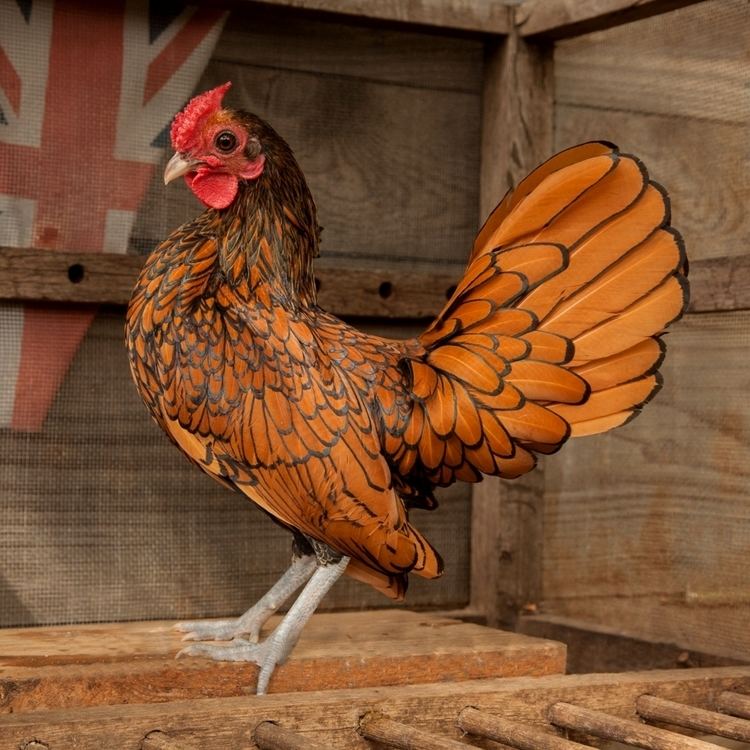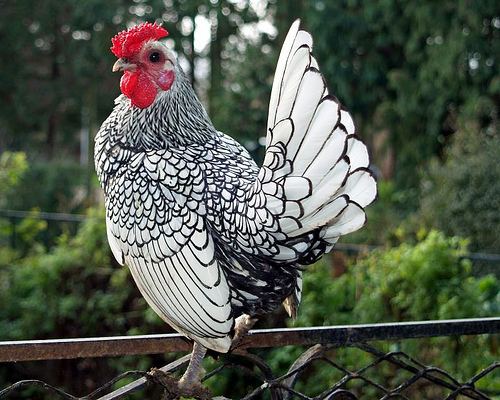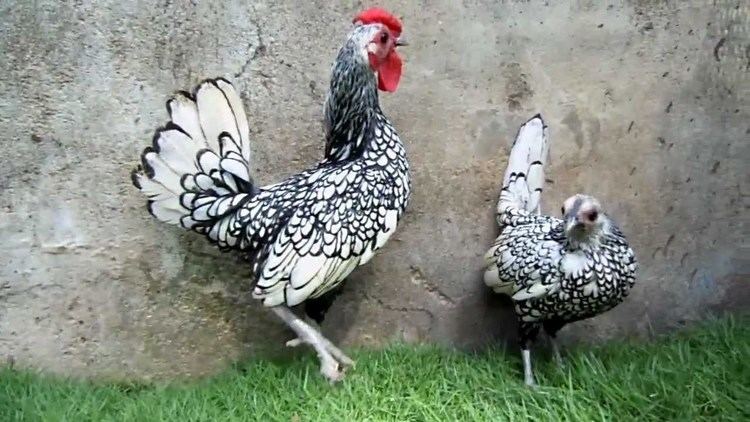Country of origin United Kingdom Comb type Rose Primary use ornamental Egg size Small Recognized variety Gold, Silver | Distribution Worldwide PCGB True Bantam Egg production (annual) 52 Temperament Friendly, Active Egg color White | |
 | ||
Conservation status At Risk (RBST), Watchlist (RBCSNZ, Endangered (RBTA) Weight Male: 22 oz.Female: 20 oz. Similar Wyandotte chicken, Polish chicken, Brahma chicken, Cochin chicken, Orpington chicken | ||
Silver sebright bantam chicken breed breeder flock
The Sebright /ˈsiːbraɪt/ is a breed of chicken named after its developer, Sir John Saunders Sebright. The Sebright is one of the oldest recorded British 'true' bantam (meaning it is a miniature bird with no corresponding large version of the breed), created in the 19th century through a selective breeding program designed to produce an ornamental breed.
Contents
- Silver sebright bantam chicken breed breeder flock
- Background
- Development
- Characteristics
- Husbandry
- References

The first poultry breed to have its own specialist club for enthusiasts, Sebrights were admitted to poultry exhibition standards not long after their establishment. Today, they are among the most popular of bantam breeds. Despite their popularity, Sebrights are often difficult to breed, and the inheritance of certain unique characteristics the breed carries has been studied scientifically. As a largely ornamental chicken, they lay tiny, white eggs and are not kept for meat production.

Background

Sir John Saunders Sebright (1767–1846) was the 7th Sebright Baronet, and a Member of Parliament for Hertfordshire . In addition to breeding chickens, cattle and other animals, Sir John wrote several influential pamphlets on animal keeping and breeding: The Art of Improving the Breeds of Domestic Animals (1809), Observations upon Hawking (1826), and Observations upon the Instinct of Animals (1836).

Charles Darwin read Sir John's 1809 pamphlet, and was impressed with a passage that elaborated on how "the weak and the unhealthy do not live to propagate their infirmities". These writings, along with Darwin's correspondence via their mutual friend William Yarrell, aided Darwin in the inception of Darwin's theory of natural selection. Darwin's seminal work On the Origin of Species, first published in 1859, cited Sir John's experiments in pigeon breeding, and recalled "That most skilful breeder, Sir John Sebright, used to say, with respect to pigeons, that 'he would produce any given feather in three years, but it would take him six years to obtain head and beak.'" Darwin also cited Sir John extensively regarding the Sebright bantam, as well as pigeon and dog breeding, in his 1868 work Variation of Plants and Animals Under Domestication, his 1871 The Descent of Man, and Selection in Relation to Sex, and his book on Natural Selection (which was not published in his lifetime).
Development

With the breed that carries his name, John Sebright intentionally set out to create a very small bantam chicken with laced plumage similar to the laced variety of Polish chickens. Although the exact makeup of the breed is uncertain, he is thought to have crossed British, Hamburgh, Nankin and Polish birds with a base of Rosecombs before achieving a laced chicken that would breed true. After the breed's establishment circa 1810, Sebright founded The Sebright Bantam Club, which was the very first individual breed association for chickens. The breed has appeared in the American Poultry Association's Standard of Perfection since the first edition in 1874. Today, the breed is one of the ten most popular bantam chickens, according to the American Bantam Association.
Characteristics

In accordance with the intentions of their creator, the Sebright is an ornamental bantam, and is commonly seen in competitive poultry shows. As a true bantam, all Sebrights are very small in stature; males weigh an average of 22 ounces (625 grams) and females 20 oz (570 g). Their short backs, proportionally large breasts, and downward–pointing wings combine to create an angular, jaunty look.
All Sebrights have plumage that is laced around the edges evenly with black, on a base of either dark gold or whitish silver. Sebrights have unfeathered legs with slate–blue skin, and their beaks are ideally a dark horn color. Sebright roosters carry a rose comb covered with fine points, and a small spike that sweeps back from the head (called a leader). Combs, earlobes and wattles were originally a purple colour referred to in the fancy as mulberry, but today are often bright red though mulberry is still desired according to the standards in most countries. Some breeders consider hen feathering to have an adverse effect on the fertility of male Sebrights, and may use roosters that don't carry the trait for breeding purposes, despite their automatic disqualification in shows.
Characteristically, Sebrights are only one of a few chicken breeds in which the roosters are hen feathered, meaning they have none of the long, sickle–shaped feathers common in most roosters that appear in the tail, neck and saddle. Due to the unique characteristic hen feathering, molecular biologists have found the Sebright bantam a useful model organism in the study of sex hormones. This is because they carry a mutation that causes the tissues of their skin to convert an unusually large amount of male sex hormones (androgens) into female sex hormones (estrogens).
They are kind birds but the male Sebright may get protective around hens and may turn on its own owners like all roosters may do. And due to their light, flighty nature it might be best to keep them contained to a smaller, fenced off area. Sebrights often will live happily living amongst other breeds as well. Sebrights are not prolific egglayers and hens are only expected to produce 60-80 creamy-white eggs each season.
Husbandry
Sebrights are neither prolific egg layers, nor outstanding meat birds. They can prove to be particularly difficult to raise, especially for beginners. Hens rarely go broody and chicks usually have high mortality rates. Adults are generally hardy birds, but are especially susceptible to Marek's disease.
In temperament, Sebrights are friendly and actively social birds. Males are not known to be aggressive, but Sebrights in general, like most small chickens, are somewhat skittish birds. Due to their small size and relatively large wings, they are one of a minority of chicken breeds that retains a strong flying ability. Thus, most keepers keep Sebrights in confinement rather than allowing them to free range. Due to their genetic make-up, males may on occasion be born infertile, further complicating breeding.
